语言学纲要(全套课件174P)
- 格式:ppt
- 大小:9.07 MB
- 文档页数:15
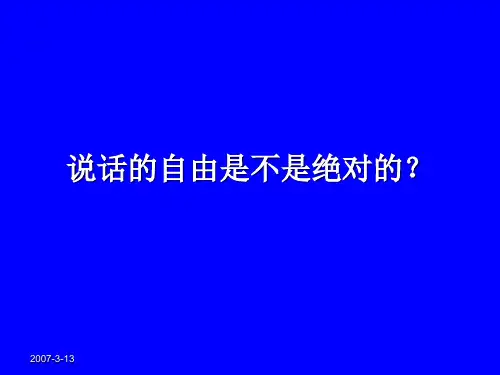

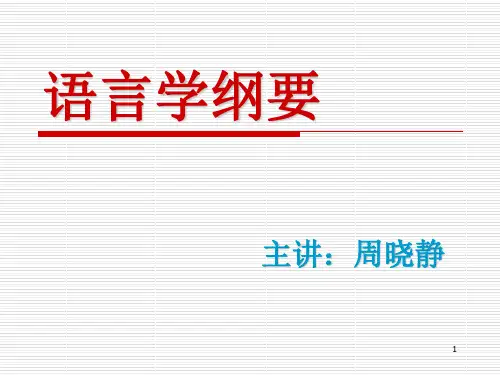


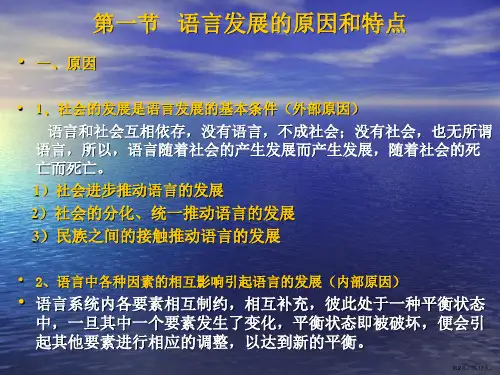
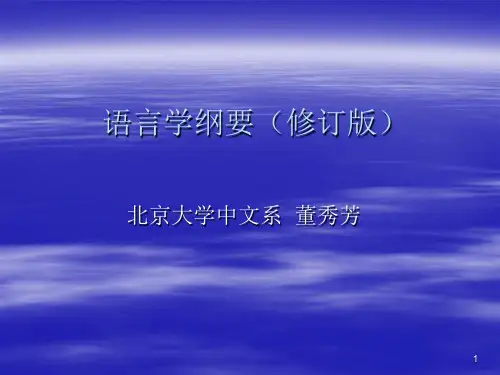
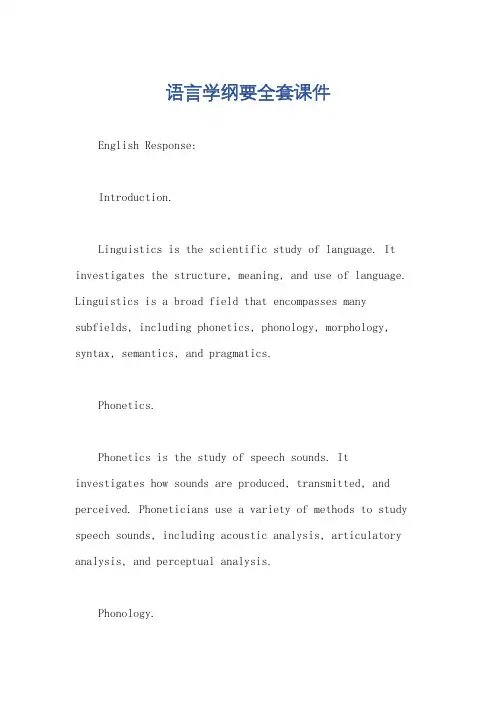
语言学纲要全套课件English Response:Introduction.Linguistics is the scientific study of language. It investigates the structure, meaning, and use of language. Linguistics is a broad field that encompasses many subfields, including phonetics, phonology, morphology, syntax, semantics, and pragmatics.Phonetics.Phonetics is the study of speech sounds. It investigates how sounds are produced, transmitted, and perceived. Phoneticians use a variety of methods to study speech sounds, including acoustic analysis, articulatory analysis, and perceptual analysis.Phonology.Phonology is the study of the sound patterns of a language. It investigates how sounds are combined to form words and how words are pronounced. Phonologists use a variety of methods to study sound patterns, including generative phonology, autosegmental phonology, and prosodic phonology.Morphology.Morphology is the study of the structure of words. It investigates how words are formed from morphemes, which are the smallest meaningful units of language. Morphologists use a variety of methods to study word structure, including inflectional morphology, derivational morphology, and compounding.Syntax.Syntax is the study of the rules that govern how words are combined to form sentences. It investigates the structure of sentences and how sentences are related toeach other. Syntacticians use a variety of methods to study syntax, including formal grammar, generative grammar, and functional grammar.Semantics.Semantics is the study of the meaning of words, phrases, and sentences. It investigates how words and phrases referto things in the world and how sentences express propositions. Semanticists use a variety of methods tostudy meaning, including truth-conditional semantics, modal semantics, and cognitive semantics.Pragmatics.Pragmatics is the study of the use of language in context. It investigates how people use language to communicate with each other and how language is used in different situations. Pragmatics is a broad field that encompasses many subfields, including speech act theory, conversation analysis, and discourse analysis.Conclusion.Linguistics is a fascinating and challenging field of study. It offers a unique perspective on the human mind and on the world around us. Linguistics is a valuable tool for understanding our own language and the languages of others.Chinese Response:语言学是语言的科学研究。

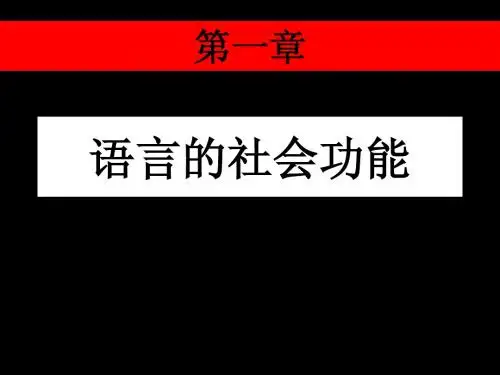

导言一、语言学的对象和任务二、语言学的建立(发展阶段)三、语言学的流派四、语言学的类别五、语言学在学科体系中的地位六、语言学的功用一、语言学的对象和任务(一)“语言学”定义:语言学是研究语言的科学。
✹研究和探讨语言的性质、结构规律和发展演变规律。
✹是通过对语言现象进行观察、调查、实验和分析,寻找语言规律的科学。
是一门多边缘、多层次的立体性学科。
(二)语言学的对象——语言从研究对象看:横向研究——包括书面语,口语和外语纵向研究——包括“活”语言和“死”语言从研究结构看:包括语音、词汇、语法、语义和文字等方面。
(三)语言学的任务✹理论上阐述语言的性质、结构和功能,通过考察语言及应用的现象,揭示语言存在和发展的规律。
✹挖掘语言本质,概括规律→总结、整理出系统的理论→指导人们的语言实践。
(四)语言学的研究方法✹语言本身构造复杂→从不同方面和角度进行研究✹研究步骤:总——分——总✹先分成语音、语义、词汇和语法四个部分→描写分析特点,比较差异→综合各种研究成果,归纳一般规律✹以汉语研究为基础,通过汉语了解语言学的基本原理和一般规律。
二、语言学的建立✹从语文学到语言学1.传统语文学――指19世纪历史比较语言学产生以前的具有附属地位的语言研究。
✹语言与人类社会同时产生→关系密切,引起注意→语言研究源于中、印、希腊文明古国(语文学三个源头)(1)印度传统✹解读经文的需要→梵语语言的研究起步早→“声明学”;《巴尼尼经》(公元前4世纪巴尼尼著,迄今为止最早的语法著作)。
(2)希腊-罗马传统哲学的巨大影响(柏拉图、亚里士多德)A、希腊语研究。
前一世纪狄奥尼修斯的《希腊语法》,把词分为8类。
公元二世纪阿波罗尼奥斯的《论句法》把句子分为主语和述语。
B、古拉丁语研究。
公元4世纪多纳图斯的《语法学》。
公元5世纪普里西安的《语法规范》。
(3)中国传统——“小学”A.文字学。
(汉)许慎《说文解字》。
(南朝)顾野王《玉篇》。
(明)梅膺祚《字彙》。